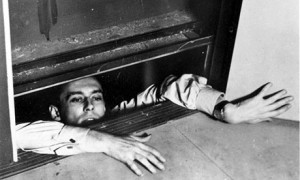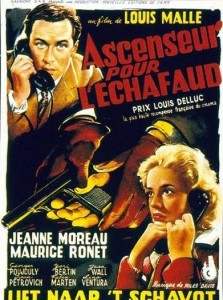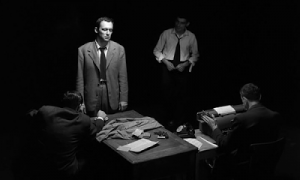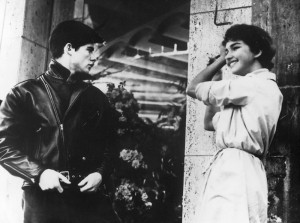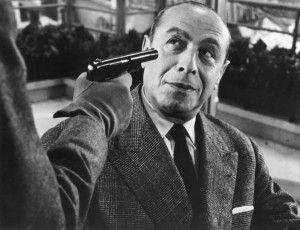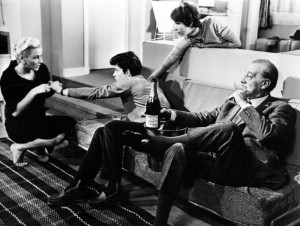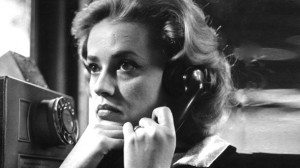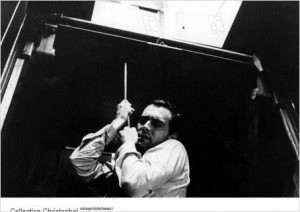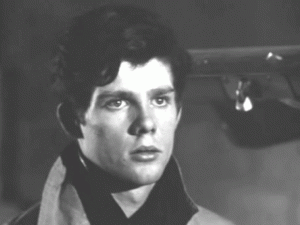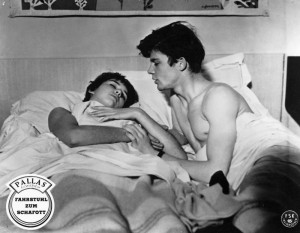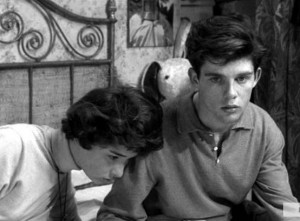Lift to the Scaffold [Ascenseur pour l’échafaud] ***** (1958, Jeanne Moreau, Maurice Ronet, Georges Poujouly, Lino Ventura) – Classic Movie Review 544
Director Louis Malle’s 1958 debut feature Ascenseur pour l’échafaud [Lift to the Scaffold] [Elevator to the Gallows] is a brilliant, haunting and complex film noir thriller. It made an international star of the 30-year-old Jeanne Moreau and ushered in the French New Wave.
Maurice Ronet stars as Julien Tavernier, a cool Parisian businessman and veteran of the Indo-China and Algetian wars, who concocts a clever perfect murder plot to shoot his arms manufacturer superior Simon Carala (Jean Wall) dead in his office above his at work and make it look like suicide – only to find when he gets out in the street that he’s left behind a vital piece of evidence.
When he goes back to try to retrieve it, he finds he’s stuck in the office lift/ elevator overnight when the janitor turns off the power for the night. He makes desperate efforts to get out before the cops come but to no avail. Meanwhile his car that he has left in the street with its keys in the ignition is made off with for a joy ride by two young lovers, teenagers Louis and Veronique (Georges Poujouly, Yori Bertin), who end up killing a couple of German tourists in a suburban motel.
The boy uses Tavernier’s revolver to kill them after the husband finds out what they’re up to. Making off in the Germans’ Mercedes, the lovers leave Ronet’s car, raincoat and gun at the crime scene.
After nine years in B-movie thrillers, Jeanne Moreau finally shoots to stardom as Florence Carala, Ronet’s co-conspirator and lover wandering the streets of Paris all night, anxiously searching for him, and wondering what the hell’s happened to him and if he’s killed her husband as she planned.
Though she’s walking around all night, the elegant, high-heeled Moreau looks like a woman who never walks at all! Lino Ventura makes a belated but effective appearance as the police inspector doggedly sniffing around the case.
The extremely confident and expert 24-year-old Malle brings the tautest and tensest of atmospheres to the well and carefully plotted, satisfying mystery story (based on Noël Calef’s novel), giving his movie the Hitchcock touch. Malle is careful to make his film as moody and atmospheric as it is suspenseful and nail-biting.
The acting of an ideal cast is first rate all round, with an outstanding Ronet as good as he is in Plein Soleil and Moreau evidently being promoted as an icon in the making. Henri Decaë’s eye-catching black and white cinematography and Miles Davis’s jazz score are major contributions to the power of this still thrilling movie.
Malle managed to persuade Davis, who was playing for a few weeks in a Paris club, to provide the marvellous improvised score. Davis watched the film just twice, then worked through one long night in a Paris studio to record this all-time great jazz score.
Malle wanted to portray a new young generation and a new Paris. ‘Traditionally, it was always the René Clair Paris that French films presented and I took care to show one of the first modern buildings in Paris. I invented a motel – there was only one motel in France and it was not near Paris, so we had to shoot in Normandy. I showed a Paris not of the future but at least a modern city, a world already somewhat dehumanised.’
Future stars Charles Denner and Jean-Claude Brialy have tiny roles as the inspector’s aide and one half of a gay couple staying at the motel. Malle pointed out that by 1958 Moreau was already ‘recognized as the prime stage actress of her generation’ after working at the Comédie Française in her twenties.
Malle explained: ‘She was lit only by the windows of the Champs Elysées. That had never been done. Cameramen would have forced her to wear a lot of make-up and they would put a lot of light on her, because, supposedly, her face was not photogenic.’
He said this lack of artifice revealed Moreau’s essential qualities. ‘She could be almost ugly and then ten seconds later she would turn her face and would be incredibly attractive. But she would be herself.’
Also in the cast are Yori Bertin, Lino Ventura, Jean Wall, Elga Andersen, Sylviane Aisenstein, Micheline Bona, Charles Denner, Gisèle Grandpré, Jacqueline Staup, Marcel Cuvelier, Gérard Darrieu, Hubert Deschamps and Jacques Hilling.
Ascenseur pour l’échafaud [Lift to the Scaffold] [Elevator to the Gallows] is directed by Louis Malle, runs 91 minutes, is made by Nouvelles Editions de Films, is released by Lux Compagnie Cinématographique de France (1958) (France), Mondial Films (1960) (UK) and Times Film Corporation (1961) (US), is written by Louis Malle (adaptation) and Roger Nimier (adaptation and dialogue), based on the novel by Noël Calef, is shot in Black and White by Henri Decaë, is produced by Jean Thuillier and is scored by Miles Davis, with Art Direction by Jean Mandaroux and Rino Mondellini.
Malle’s next two films were The Lovers [Les Amants], reuniting him with Moreau, and Zazi dans le Métro, both icons of the French New Wave.
Louis Malle died of lymphoma on, aged 63. Perhaps his best known and most admired film is Au Revoir Les Enfants (1987), re-released in the UK on 30 January 2015.
Georges Poujouly died of cancer onaged 60.
Jeanne Moreau died of natural causes on 31 aged 89. Her last film was in 2015.
http://derekwinnert.com/au-revoir-les-enfants-1987-classic-movie-review-1927/
© Derek Winnert 2013 Classic Movie Review 544
Check out more reviews on http://derekwinnert.com/



